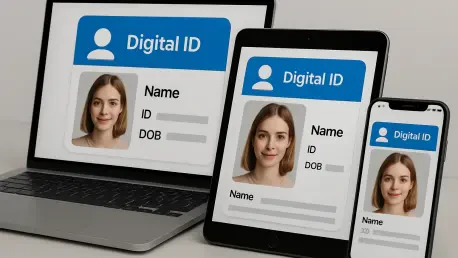Imagine a world where leaving the house for a domestic flight doesn’t require fumbling through a wallet for a physical passport or ID, but instead, a quick tap on a smartphone or smartwatch grants access through airport security. This scenario is becoming a reality as Apple introduces its groundbreaking Digital ID feature for iPhone and Apple Watch users in the United States. This innovation allows travelers to carry a digital copy of their U.S. passport directly on their devices, streamlining the process at TSA checkpoints in over 250 airports nationwide. As part of the latest iOS release, this feature marks a significant step toward replacing traditional wallets with digital alternatives. Beyond convenience, it promises enhanced security and privacy, reshaping how identity verification is handled in everyday situations. This development not only caters to tech-savvy travelers but also sets a new standard for how personal identification can be managed in a digital age, paving the way for broader applications.
1. A New Era of Digital Identification
The Digital ID feature, now available in Apple Wallet, extends beyond existing support for government-issued IDs to include U.S. passports, offering a versatile solution for domestic travel. Initially rolled out across a dozen states and Puerto Rico, with plans for further expansion, this functionality ensures that even those without a REAL ID-compliant driver’s license or state ID can create and present a valid digital identification. Apple emphasizes that this digital version does not replace a physical passport and is currently limited to domestic use, excluding international travel or border crossings. The integration into Apple Wallet aligns with the company’s broader vision of making iPhones and Apple Watches a complete replacement for physical wallets, capable of storing payment cards, tickets, loyalty cards, and now critical identification documents. This move reflects a growing trend toward digitization in personal security, addressing the needs of millions who seek efficiency without sacrificing safety or reliability in their daily interactions.
Adding a passport to Apple Wallet is a straightforward yet secure process designed to prioritize user privacy and authenticity. Users can begin by tapping the “Add” button in the Wallet app, selecting “Driver’s License or ID Cards,” and choosing the Digital ID option. The setup requires scanning the photo page of the passport and the embedded chip on the back to verify its legitimacy, followed by a selfie and a series of facial and head movements for additional security confirmation. This multi-step verification ensures that the digital ID is tied directly to the rightful owner, minimizing risks of fraud or misuse. Unlike traditional methods where physical IDs might be handed over, this digital solution allows users to maintain control over their information, sharing only what is necessary during verification. The process showcases Apple’s commitment to blending user-friendly design with robust security measures, setting a benchmark for how sensitive personal data can be managed on personal devices in an increasingly connected world.
2. Seamless Usage at TSA Checkpoints and Beyond
Using the Digital ID at TSA checkpoints mirrors the familiar ease of Apple Pay, ensuring a smooth experience for travelers. By double-clicking the side or Home button on an iPhone or Apple Watch, users can access their Wallet, select the Digital ID, and hold the device near an identity reader. Authentication is completed via Face ID or Touch ID, allowing users to confirm their identity without unlocking their device or handing it over. Additionally, the system displays what specific information is being requested before sharing, giving users transparency and control over their data. Although still in beta, with not all TSA checkpoint readers fully equipped for this technology, the feature is a promising glimpse into a future of frictionless travel. The TSA advises carrying a physical ID as a backup, but the gradual rollout across more than 250 U.S. airports signals a transformative shift in how identity verification is conducted at key travel hubs.
Beyond airports, the potential applications of Digital ID are vast, extending into everyday scenarios where age or identity verification is required. Apple envisions users presenting their digital ID at businesses like bars or event venues to confirm they are of legal drinking age, or even online for services requiring adult verification, such as ordering alcohol for delivery. In these cases, users can share only that they are over 21, without disclosing additional personal details like name, address, or birthdate. This selective sharing capability enhances privacy, addressing common concerns about oversharing sensitive information in both physical and digital environments. As support for this feature grows, it could redefine interactions with various organizations, making identity checks more efficient while safeguarding user data. The adaptability of this technology hints at a future where digital verification becomes the norm across multiple sectors, from hospitality to e-commerce, fundamentally changing how personal identity is managed.
3. Privacy and Security at the Core
A cornerstone of the Digital ID feature is Apple’s focus on privacy, ensuring that users retain full control over their personal information. The company states that it has no access to when or where a user presents their ID, nor does it track the specific data shared during verification. This hands-off approach means that interactions remain confidential, with users not required to unlock their devices or relinquish them to complete the process. Similar to Apple Pay, the verification is seamless and secure, relying on encrypted communication between the device and the reader. This design not only protects against unauthorized access but also builds trust among users who may be wary of storing sensitive documents digitally. By prioritizing privacy in this manner, Apple addresses a critical concern in the digital age, where data breaches and identity theft remain persistent threats, offering a model for how technology can balance convenience with stringent security protocols.
Looking back, the introduction of Digital ID marked a pivotal moment in the evolution of personal identification, reflecting a broader shift toward digital solutions in everyday life. As the feature gained traction, it became clear that the journey toward fully replacing physical wallets had taken a significant leap forward. The emphasis on user control and data protection set a precedent for future innovations in this space. Moving ahead, travelers and consumers were encouraged to stay informed about the expanding availability of Digital ID across more states and venues, ensuring they could leverage this technology as it matured. Exploring how businesses and online platforms might integrate this verification method offered an opportunity to streamline processes further. As the digital landscape continued to evolve, keeping abreast of updates from Apple and TSA ensured that users maximized the benefits of this cutting-edge tool, paving the way for a more connected and secure future in identity management.









